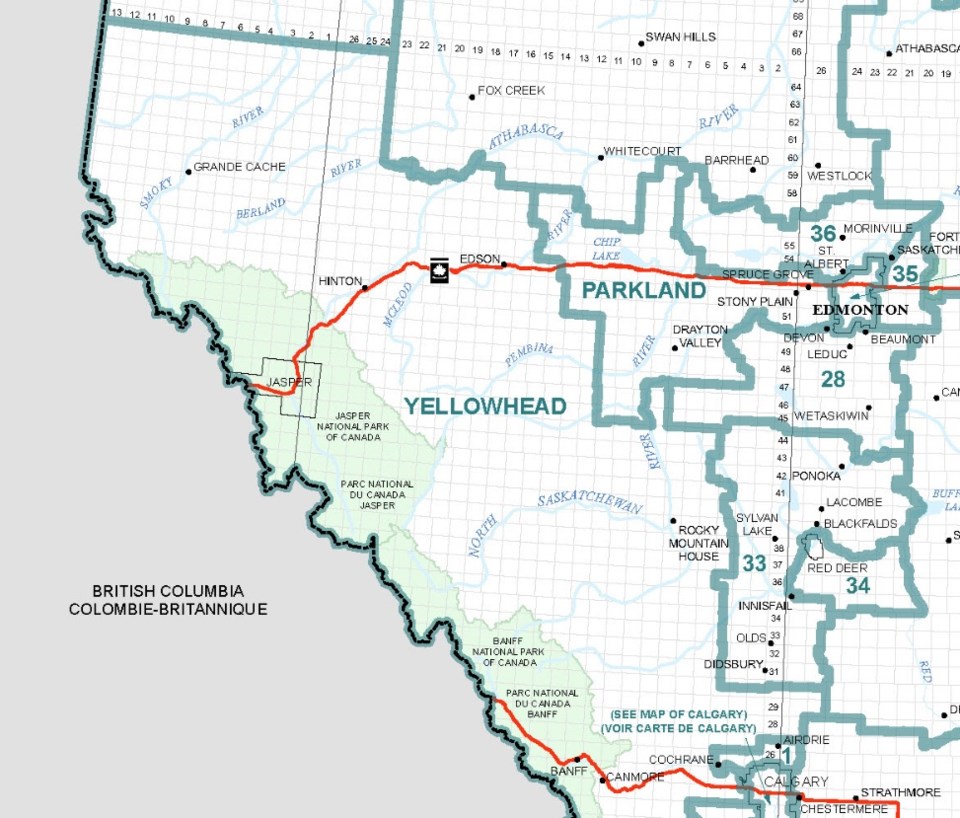Scott Hayes | [email protected]
Local Journalism Initiative Reporter
Banff and Canmore are set to become Jasper's new neighbours, federally speaking.
The Federal Electoral Boundaries Commission's Final Report, which was tabled in the House of Commons on July 20, shuffles the boundaries around to create the new Yellowhead electoral district that will include the mountain communities. The new riding will still hold Edson and Hinton along with west Yellowhead County within its edges.
Conservative MP Gerald Soroka voiced his concerns over the sprawling territory that the new Yellowhead riding encompasses.
"I've always tried to represent Yellowhead to the best of my abilities and tried to go to all various communities, but now with there being so many more communities, are you going to be able to do an effective job when 40 per cent of your time is in Ottawa?" he asked.
The new riding brings Grande Cache, Rocky Mountain House, Sundre, Caroline, Cremona, Carstairs and Crossfield into the fold, as well as the summer villages of Burnstick Lake, Ghost Lake and Waiporous.
It will also include the municipal districts of Bighorn No. 8 and Clearwater County plus Improvement District No. 12 Jasper Park, Improvement District No. 25 Willmore Wilderness, Improvement District No. 9 Banff and Kananaskis Improvement District, together with the Indian Reserves of Big Horn No. 144A, O’Chiese No. 203, Stoney No. 142, 143, 144, Stoney No. 142B and Sunchild No. 202.
As part of the process of redistribution of federal electoral districts, a non-partisan panel is convened in the province approximately every decade to reexamine federal electoral lines and establish new definitions of ridings.
This works to account for Alberta's changing population and changes to ridings primarily take populations into account as part of its representation formula.
Each riding is trying to centre around having 116,000 residents in an effort to equalize the weight of each person's vote across the province. There are 115,086 residents in the communities in the new Yellowhead riding, according to the Final Report.
As stipulated in the Constitution Act, the Commission does have the ability to consider other criteria, including communities of identity and interest. Its original proposal was to separate Banff and Canmore, but after hearing many objections, that was scrapped to keep them together.
Last fall, the Commission had hearings in Banff to hear people's concerns. Mayor Richard Ireland attended in order to express his support that both Jasper and Banff have a common interest in that they are communities based on a tourism economy.
Ireland said this is a much different picture in the current riding that is soon to be modified.
"We're lumped in with everybody east of the Rockies: everybody from farming to agriculture to oil and gas and forestry. It's all about resource extraction. Jasper is all by itself as a resource protector," he said.
"But we have an interest with Banff in particular and with Canmore as a resource protector. That's the essence of our entire local economy is protecting the resource so people can come and see it. That coupled with the fact that Jasper and Banff are the only two incorporated municipalities in national parks in all of Canada. We have so many common interests, it just makes sense that we would be in the same writing, at least from my perspective."
This still leaves Soroka with further questions.
"In order to make Yellowhead [riding] work, they went and split Yellowhead County in half, and now Rocky View County can have four MPs for it. Isn't that somewhat disjointed?" he said.
The Commission is an independent, three-person body responsible for defining the sizes, boundaries and names of the federal electoral districts within the Province of Alberta.
Once the Final Report was tabled, the Federal Electoral Boundaries Commission for Alberta became defunct, a representative from Elections Canada explained in an email to the Fitzhugh.
Electoral districts for each province are determined by the formula and rules set out in the Constitution Act. The number of seats allocated to the Province of Alberta will increase from 34 to 37 under this recent redistribution.
The total number of seats in the House of Commons will increase from 338 to 343.




